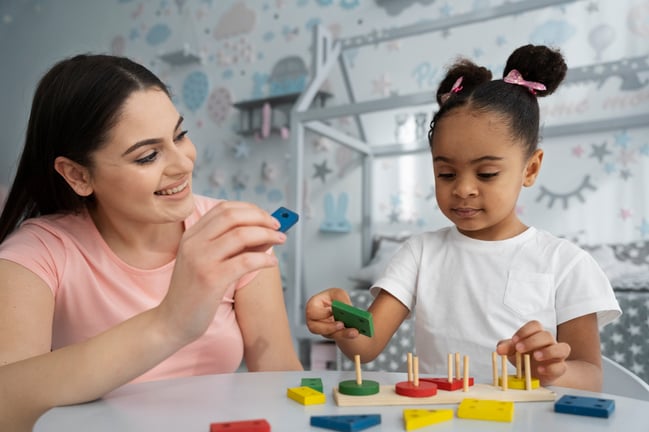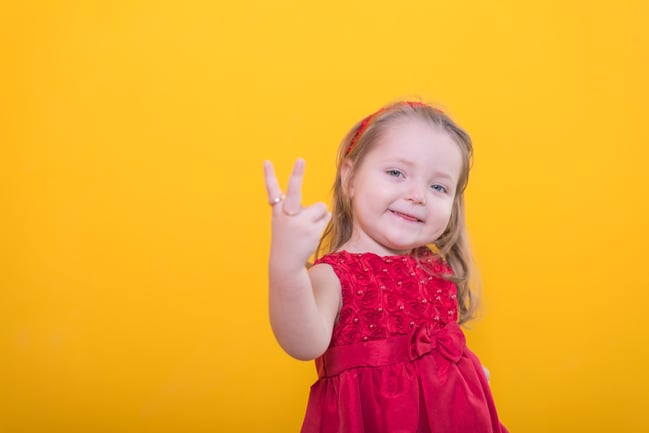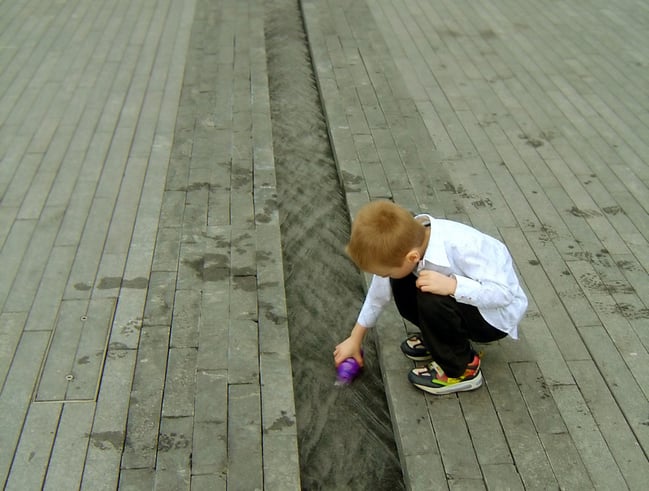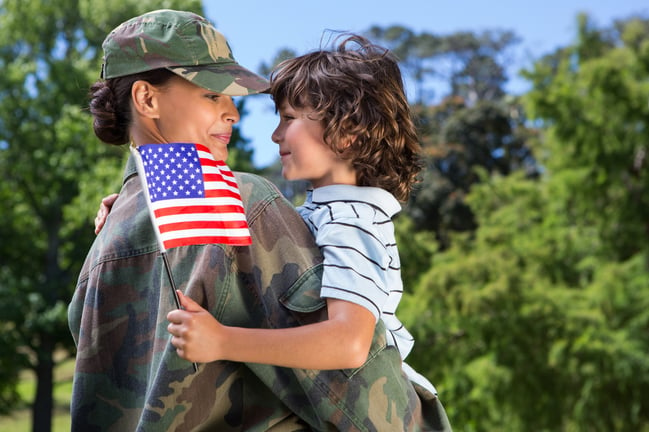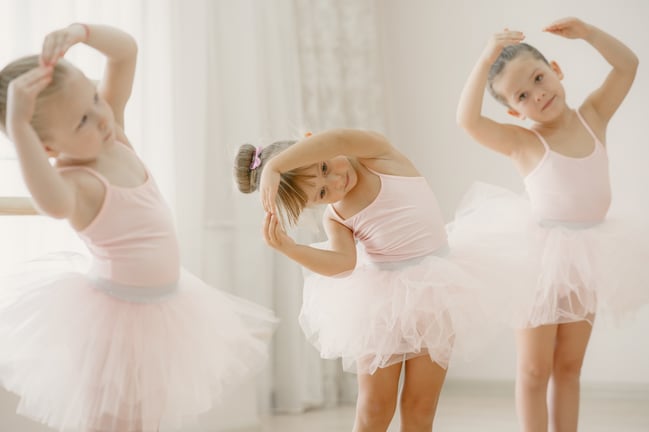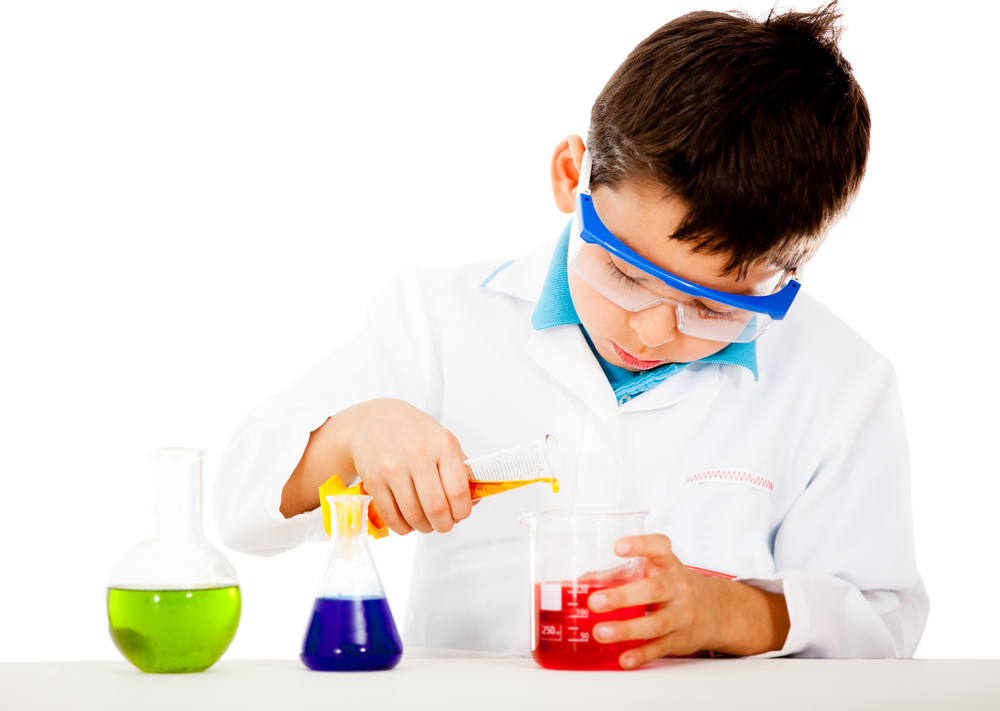
Cognitive Development Domain
Younger Preschoolers (33 to 48 months)
Components and Developmental Indicators
Younger Preschoolers (33 to 48 months)
Components and Developmental Indicators
Developmental Indicators
CD Goal-1: Through their explorations, play, and social interactions, children use their senses to discover and construct knowledge about the world around them.
![]()
Intentionally explore and investigate objects, tools, and materials to learn about their properties (weigh an object, observe something from the top and from the bottom).
![]()
Share something they have discovered through their senses using play, art, language, and other forms of representation (“This smells like the flower at Grandma’s.”).
![]()
Group familiar objects that go together (shoe and sock, brush and paint, hammer and nail).
CD Goal-2: Through their explorations, play, and social interactions, children recall information and apply it to new situations and problems.
![]()
Recognize whether a picture or object is the same as or different from something they have seen before.
![]()
Apply what they know about everyday experiences to new situations (look for the seatbelt on the bus).
![]()
Describe or act out a memory or a situation or action, with adult support.
![]()
Express expectations based on past experiences (“We brush our teeth after we eat.”).
![]()
Make predictions about what will happen using what they know.
![]()
Use multiple strategies to solve problems, including trial and error, simple tools, or asking for help (try to fix a broken toy by taping it back together).
![]()
Introduce ideas or actions in play based on previous knowledge or experience.
![]()
Ask questions about why things happen to build their understanding of the cause and effect.
CD Goal-3: Through their explorations, play, and social interactions, children demonstrate the ability to think about their own thinking: reasoning, taking perspectives, and making decisions.
![]()
Use language to identify pretend or make-believe situations (“Let’s pretend we’re going on a trip.”).
![]()
Use words like “think” and “know” to talk about thoughts and beliefs.
![]()
Recognize that beliefs and desires can determine what people do (person will look for a missing object based on where they think it is rather than where it actually is).
Developmental Indicators
CD Goal-4: Through their explorations, play, and social interactions, children count with understanding and use numbers to tell how many, describe order, and compare.
![]()
Count 10 by ones with increasing accuracy.
![]()
Count up to 5 objects arranged in a line using one-to-one correspondence with increasing accuracy, and answer the question “How many?”
![]()
Compare two groups (containing up to 5 objects each) and compare them in terms of more, less, fewer, or equal.
![]()
Show they understand that adding objects to a group will make a bigger group and taking away objects will make a smaller group.
CD Goal-5: Through their explorations, play, and social interactions, children demonstrate concepts about position, as well as identify and describe simple geometric shapes.
![]()
Demonstrate and begin to use the language of the relative position of objects in the environment and play situations, such as up, down, over, under, top, bottom, inside, outside, in front, behind, between, next to.
![]()
Build and describe 2-dimensional shapes, such as making circles and triangles with blocks and play dough.
![]()
Find shapes in the environment and describe them in their own words.
CD Goal-6: Through their explorations, play and social interactions, children compare, sort, group, organize, measure, and create simple patterns using concrete objects.
![]()
Use simple measurement tools with guidance and support to measure objects (a ruler, measuring cup, scale).
![]()
Compare the size or weight of two objects and identify which one is longer/taller/heavier that the other (“That rock is heavier than this one; I can’t lift it.” “A cow is bigger than a cat.”).
![]()
Identify familiar objects as the same or different.
![]()
Sort familiar objects into categories with increasing accuracy (tools for woodworking and utensils for cooking, rectangle blocks on one shelf and square blocks on another shelf).
![]()
Recognize simple repeating patterns and attempt to create them during play (repeat a movement pattern during a song, make a line of blocks in alternating colors).
CD Goal-7: Through their explorations, play, and social interactions, children use mathematical thinking to ask questions and solve problems.
![]()
Seek answers to questions by using mathematical thinking during play and daily activities (determine who is taller by standing next to classmate, find two smaller blocks to replace larger block).
![]()
Use observation and counting (not always correctly) to find out how many things are needed during play and other daily activities (figure out how many spoons are needed for snack, find enough dolls so each person has one when playing in the dramatic play area).
Developmental Indicators
CD Goal-8: As a result of their explorations and participation in simple investigations through play, children observe, describe, and demonstrate respect for living things, the environment, and the physical world.
![]()
Demonstrate interest in the natural world and the outdoor environment (plays in dirt and sand, ask questions about things seen outdoors).
![]()
Participate in activities that help to care for the environment, with guidance and support (picks up trash, recycle paper).
![]()
Participate in the care of living things with guidance and support (water plants, help to feed classroom pet).
![]()
Notice and describe characteristics of plants and animals, such as appearance, similarities, differences, behavior, and habitat.
![]()
Investigate the effect they can have on motion (push, pull, build ramp for a toy car with blocks, put foot in the path of moving toy).
![]()
Notice and describe properties of materials and changes in substances (water freezes into ice, pudding thickens, clay hardens).
![]()
Compare and sort objects or materials according to one or more attributes.
![]()
Observe and state simple weather patterns (sunny, rainy, cloudy, snowy).
CD Goal-9: As a result of their explorations and participation in simple investigations through play, children demonstrate their ability to use scientific inquiry by observing, manipulating objects, asking questions, making predictions, and developing generalizations.
![]()
Represent learned scientific exploration through simple drawings, building, movement, or other methods, with adult support.
![]()
Use simple tools and measuring devices (balance scales, sifter, and rulers) to explore the environment, with guidance and support.
![]()
Observe objects, materials, and phenomena and describe what they notice (temperature, texture, size, weight, color, etc.).
![]()
State a purpose when constructing something new (“I’m gonna build a bridge for my dump truck.”).
![]()
Test a variety of materials and configurations to design a product.
![]()
Ask questions to find out more about the natural world.
![]()
With adult support, make simple predictions about what will happen next.
![]()
Use simple descriptions and scientific vocabulary during experiments and experiences, with adult prompting and support (describe changes taking place while mixing, and using words such as “question,” “experiment,” and “measure”).
Developmental Indicators
CD Goal-10: Through their explorations, play, and social interactions, children demonstrate an understanding of relationships, roles, and what it means to be a participating member of their families and the diverse groups/communities they belong to.
![]()
Talk about close family members, name their relationships to each other, and describe family routines (“Marika is my sister.” “My grandma takes care of me at night.”).
![]()
Adopt roles of family and community members during play, given support and realistic props.
![]()
Identify self as a part of a specific family, preschool class, or other familiar group (point to picture and say, “That’s my family.” or “I’m in Ms. Emily’s class.”).
![]()
With prompting and support, participate as a member of a group, such as a classroom community (vote for name of class pet, wait turn to paint when easels are full).
![]()
Talk about “fairness” and demonstrate a willingness to take turns and share with others.
CD Goal-11: Through their explorations, play, and social interactions, children identify and demonstrate appreciation of similarities and differences between themselves and others.
![]()
Show acceptance of people who are different from themselves as well as people who are similar.
![]()
Explore differences in backgrounds and traditions during play and planned activities, given support and guidance (try on various traditional outfits in the dramatic play area).
Developmental Indicators
CD Goal-12: Children engage in a variety of creative activities for enjoyment and self-expression including play, visual arts, music, expressive movement, and drama.
![]()
Explore the properties of art materials and use them for constructing, painting, drawing, and sculpting.
![]()
Choose to participate and use visual art, music, movement, and dramatic play to communicate and express feelings, ideas, and experiences.
![]()
Show creativity and imagination when using materials, singing, moving, and assuming roles during pretend play.
![]()
Use words and actions to imitate a variety of familiar stories, roles, and new understandings from topics of study (set up a store in the dramatic play area and act out roles of shopkeeper and customer).
![]()
Show awareness of different musical instruments, and rhythms, as they make music or participate in music activities.
![]()
Show awareness of various patterns of beat, rhythm, and movement through music and movement activities.
![]()
Explore more ways to move imaginatively with and without music (stretching, galloping, twisting, bending, swaying, marching, and clapping).
CD Goal-13: Children demonstrate an appreciation for different forms of art including visual arts, music, expressive movement, and drama.
![]()
Express pleasure in different forms of art (call something “pretty,” express preferences, or listen to music again).
![]()
Participate in and use words to describe art in terms of color, texture, space, sound and movement.

